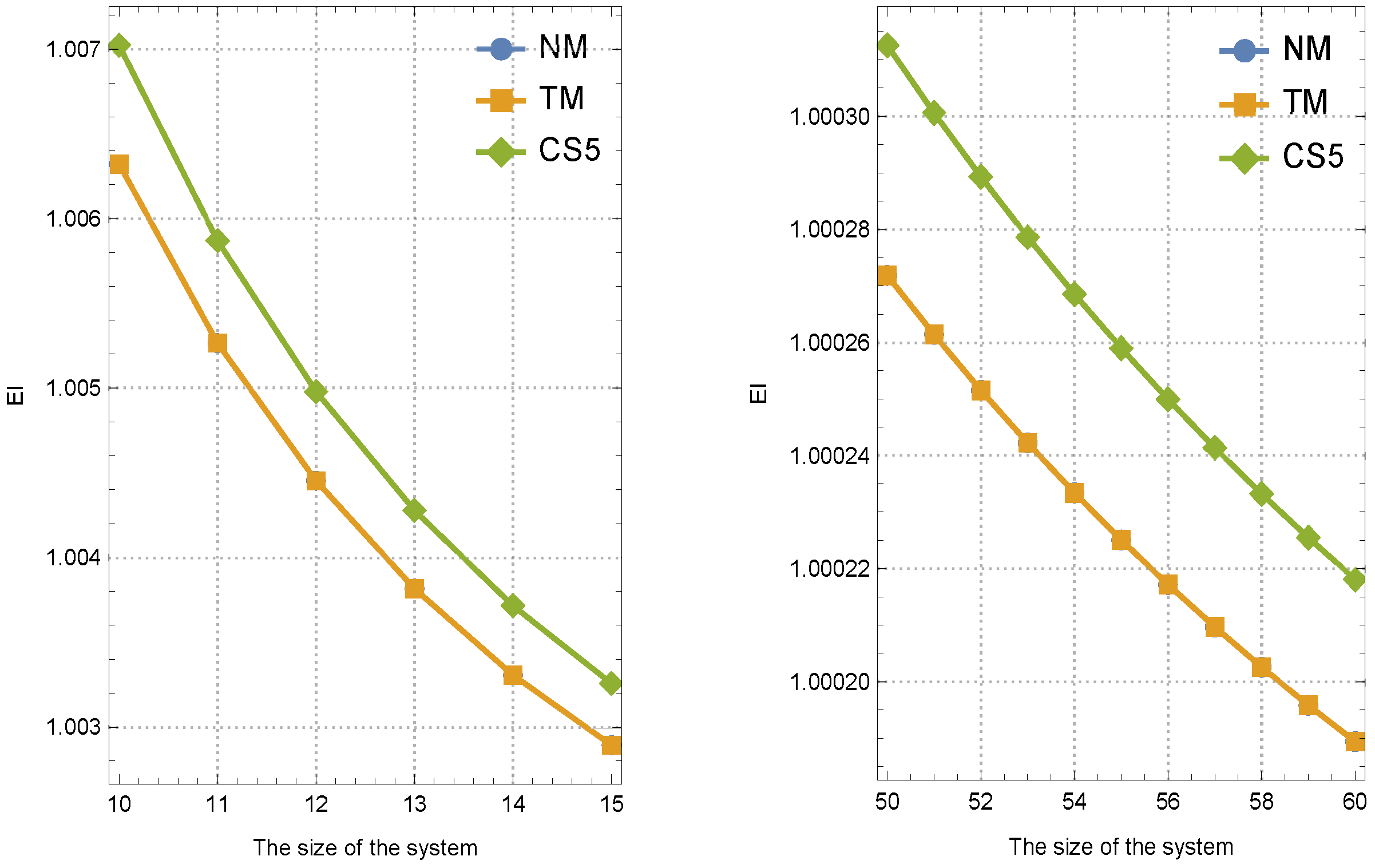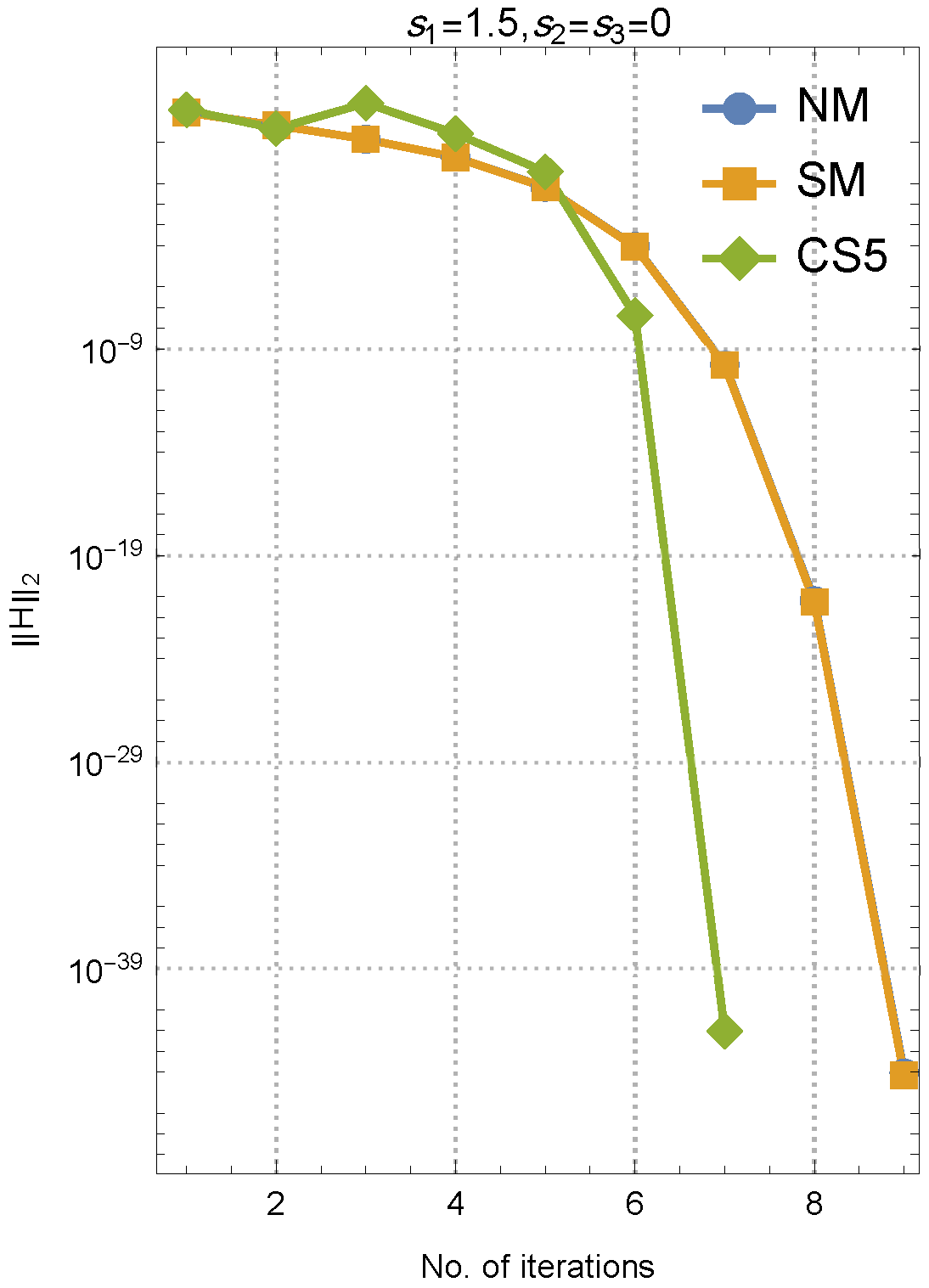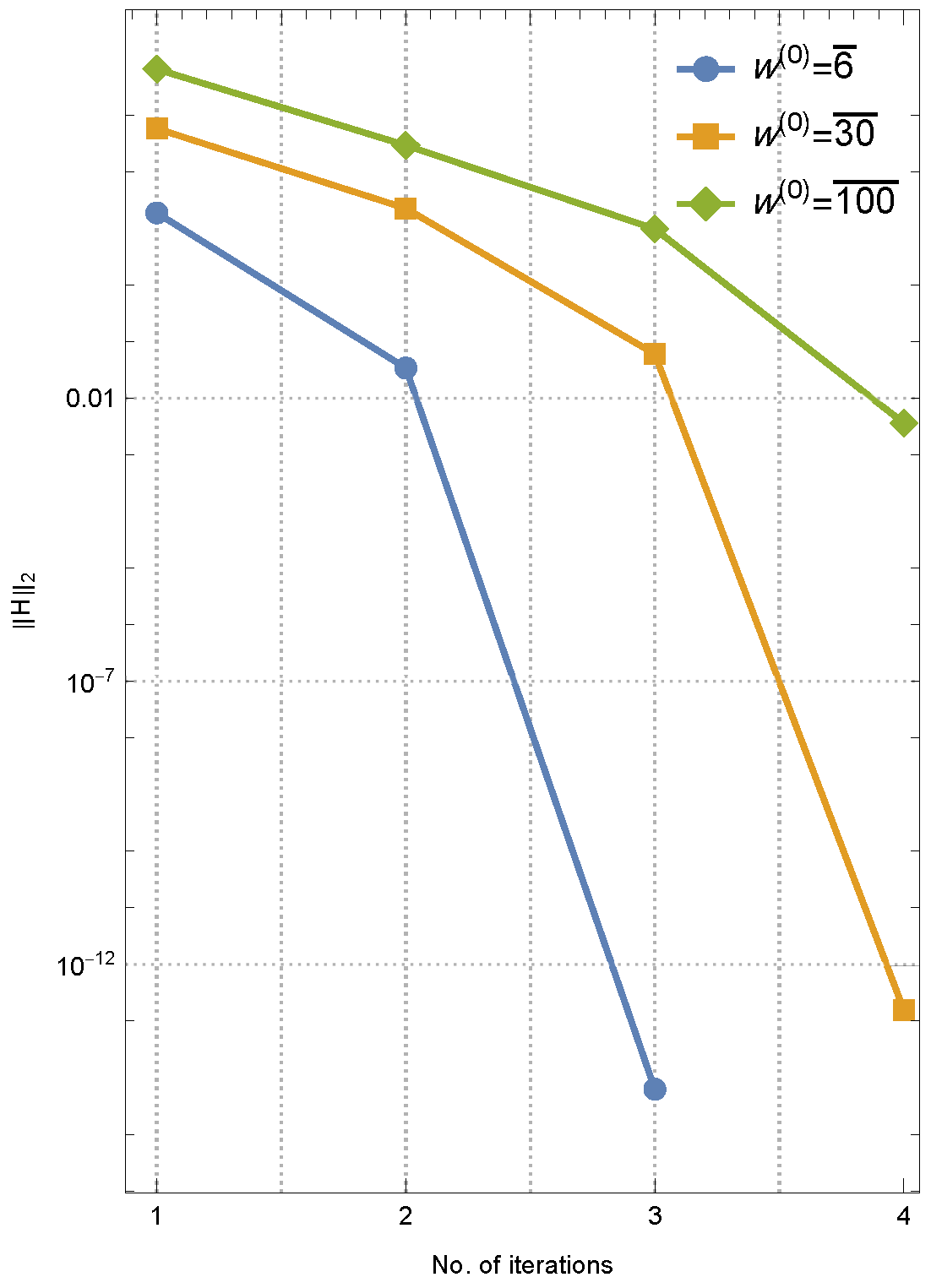On the Derivation of a Fast Solver for Nonlinear Systems of Equations Utilizing Frozen Substeps with Applications
Abstract
1. Preliminary Discussion
1.1. Nonlinear Equations
1.2. The Need in Differential Equations
1.3. Our Aim and Contribution
1.4. Existing Approaches
1.5. Outlines
2. A Novel Iterative Framework
3. Investigating the Convergence Rate
4. Numerical Tests
- Computational experiments were performed using Wolfram software 13.3 [23,24], with all programming conducted in a multiple-precision arithmetic framework using 2500-digit precision except the last test. This setup allowed us to rigorously observe and verify the higher speeds reflected in the computational pieces of evidence.
- Linear systems arising during the process were efficiently solved through LU factorization using .
- All numerical tests were carried out in a consistent computational environment to ensure reliability and reproducibility.
- For comparative analysis, the proposed higher-order method was benchmarked against existing approaches, including NM and SM, for resolving nonlinear collections of equations.
- shows the cost, and
- shows the rate in terms of function evaluations.
Discussion
5. Summary
Author Contributions
Funding
Data Availability Statement
Conflicts of Interest
References
- Soheili, A.R.; Amini, M.; Soleymani, F. A family of Chaplygin–type solvers for Itô stochastic differential equations. Appl. Math. Comput. 2019, 340, 296–304. [Google Scholar] [CrossRef]
- Behl, R. A derivative free fourth-order optimal scheme for applied science problems. Mathematics 2022, 10, 1372. [Google Scholar] [CrossRef]
- Gdawiec, K.; Kotarski, W.; Lisowska, A. Visual analysis of the Newton’s method with fractional order derivatives. Symmetry 2019, 11, 1143. [Google Scholar] [CrossRef]
- Chanu, W.H.; Panday, S.; Thangkhenpau, G. Development of optimal iterative methods with their applications and basins of attraction. Symmetry 2022, 14, 2020. [Google Scholar] [CrossRef]
- Ortega, J.M.; Rheinboldt, W.C. Iterative Solutions of Nonlinear Equations in Several Variables; Academic Press: New York, NY, USA, 1970. [Google Scholar]
- Traub, J. Iterative Methods for the Solution of Equations, 2nd ed.; Chelsea Publishing Company: New York, NY, USA, 1982. [Google Scholar]
- Wang, X.; Zhang, T.; Qin, Y. Efficient two-step derivative-free iterative methods with memory and their dynamics. Int. J. Comput. Math. 2016, 93, 1423–1446. [Google Scholar] [CrossRef]
- Proinov, P.D. New general convergence theory for iterative processes and its applications to Newton-Kantorovich type theorems. J. Complex. 2010, 26, 3–42. [Google Scholar] [CrossRef]
- Ivanov, S.I. A general approach to the study of the convergence of Picard iteration with an application to Halley’s method for multiple zeros of analytic functions. J. Math. Anal. Appl. 2022, 513, 126238. [Google Scholar] [CrossRef]
- Qasim, S.; Ali, S.; Ahmad, F.; Serra-Capizzano, S.; Ullah, M.Z.; Mahmood, A. Solving systems of nonlinear equations when the nonlinearity is expensive. Comput. Math. Appl. 2016, 71, 1464–1478. [Google Scholar] [CrossRef]
- Soheili, A.R.; Soleymani, F. Iterative methods for nonlinear systems associated with finite difference approach in stochastic differential equations. Numer. Algorithms 2016, 71, 89–102. [Google Scholar] [CrossRef]
- Cordero, A.; Jordán, C.; Sanabria-Codesal, E.; Torregrosa, J.R. Solving nonlinear vectorial problems with a stable class of Jacobian-free iterative processes. J. Appl. Math. Comput. 2024, 70, 5023–5048. [Google Scholar] [CrossRef]
- Shil, S.; Nashine, H.K.; Soleymani, F. On an inversion-free algorithm for the nonlinear matrix problem Xα + A*X−βA + B*X−γB = I. Int. J. Comput. Math. 2022, 99, 2555–2567. [Google Scholar] [CrossRef]
- Abdullah, S.; Choubey, N.; Dara, S. An efficient two-point iterative method with memory for solving non-linear equations and its dynamics. J. Appl. Math. Comput. 2023, 70, 285–315. [Google Scholar] [CrossRef]
- Cordero, A.; Garrido, N.; Torregrosa, J.R.; Triguero-Navarro, P. Design of iterative methods with memory for solving nonlinear systems. Math. Method. Appl. Sci. 2023, 46, 12361–12377. [Google Scholar] [CrossRef]
- Batra, P. Simultaneous point estimates for Newton’s method. BIT 2002, 42, 467–476. [Google Scholar] [CrossRef]
- McNamee, J.M.; Pan, V.Y. Numerical Methods for Roots of Polynomials—Part I; Elsevier: Amsterdam, The Netherlands, 2007. [Google Scholar]
- Kyncheva, V.K.; Yotov, V.V.; Ivanov, S.I. Convergence of Newton, Halley and Chebyshev iterative methods as methods for simultaneous determination of multiple polynomial zeros. Appl. Numer. Math. 2017, 112, 146–154. [Google Scholar] [CrossRef]
- McNamee, J.M.; Pan, V.Y. Numerical Methods for Roots of Polynomials—Part II; Elsevier: Amsterdam, The Netherlands, 2013. [Google Scholar]
- Grau-Sánchez, M.; Grau, À.; Noguera, M. On the computational efficiency index and some iterative methods for solving systems of nonlinear equations. J. Comput. Appl. Math. 2011, 236, 1259–1266. [Google Scholar] [CrossRef]
- Sharma, J.R.; Guha, R.K.; Sharma, R. An efficient fourth order weighted-Newton method for systems of nonlinear equations. Numer. Algorithms 2013, 62, 307–323. [Google Scholar] [CrossRef]
- Cordero, A.; Hueso, J.L.; Martínez, E.; Torregrosa, J.R. A modified Newton-Jarratt’s composition. Numer. Algorithms 2010, 55, 87–99. [Google Scholar] [CrossRef]
- Dubin, D. Numerical and Analytical Methods for Scientists and Engineers Using Mathematica; John Wiley & Sons: Hoboken, NJ, USA, 2003. [Google Scholar]
- Clark, J.; Kapadia, D. Introduction to Calculus: A Computational Approach; Wolfram Media: Champaign, IL, USA, 2024. [Google Scholar]





| Techniques | NM | SM | PM |
|---|---|---|---|
| 2 | 2 | 5 | |
| Functional evaluations | |||
| No. of LU factorization | 1 | 1 | 2 |
| The classic EI |
| Methods | ||||
|---|---|---|---|---|
| NM | ||||
| SM | ||||
| CS5 |
Disclaimer/Publisher’s Note: The statements, opinions and data contained in all publications are solely those of the individual author(s) and contributor(s) and not of MDPI and/or the editor(s). MDPI and/or the editor(s) disclaim responsibility for any injury to people or property resulting from any ideas, methods, instructions or products referred to in the content. |
© 2025 by the authors. Licensee MDPI, Basel, Switzerland. This article is an open access article distributed under the terms and conditions of the Creative Commons Attribution (CC BY) license (https://creativecommons.org/licenses/by/4.0/).
Share and Cite
Liu, M.; Shateyi, S. On the Derivation of a Fast Solver for Nonlinear Systems of Equations Utilizing Frozen Substeps with Applications. Axioms 2025, 14, 77. https://doi.org/10.3390/axioms14020077
Liu M, Shateyi S. On the Derivation of a Fast Solver for Nonlinear Systems of Equations Utilizing Frozen Substeps with Applications. Axioms. 2025; 14(2):77. https://doi.org/10.3390/axioms14020077
Chicago/Turabian StyleLiu, Mingming, and Stanford Shateyi. 2025. "On the Derivation of a Fast Solver for Nonlinear Systems of Equations Utilizing Frozen Substeps with Applications" Axioms 14, no. 2: 77. https://doi.org/10.3390/axioms14020077
APA StyleLiu, M., & Shateyi, S. (2025). On the Derivation of a Fast Solver for Nonlinear Systems of Equations Utilizing Frozen Substeps with Applications. Axioms, 14(2), 77. https://doi.org/10.3390/axioms14020077






